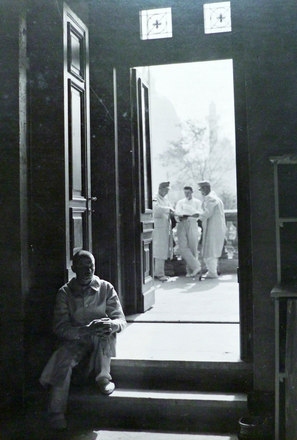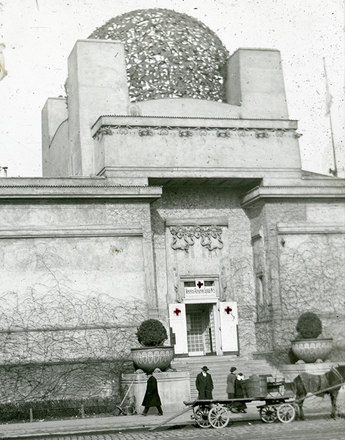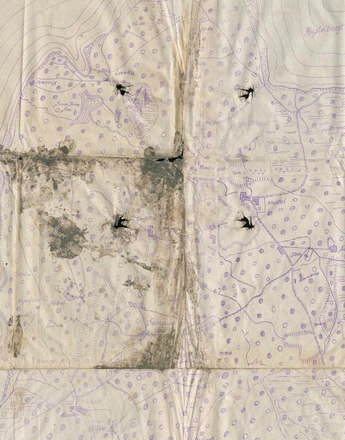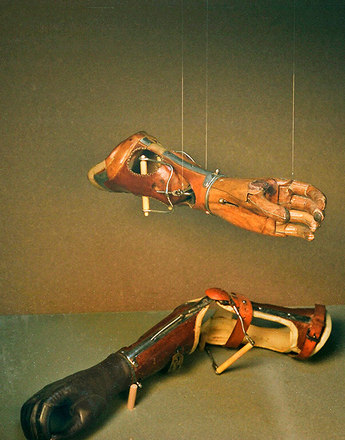Künstlerhaus and Secession as temporary war hospitals
-

The Vienna Secession as Association Reserve Hospital, photo, taken on 21 February 1915
Copyright: Wiener Stadt- und Landesarchiv
Partner: Universitätsbibliothek Wien -

Medical chart of the wounded infantry soldier Jova Markovic, patient at the Substitute Hospital in the Vienna Künstlerhaus, photo taken on 8 October 1918
Copyright: Künstlerhaus Archiv, Mappe Lazarett
Partner: Künstlerhaus Archiv
Artists’ associations and artists were also caught up in the war fervour and made themselves available to the fatherland. The Künstlerhaus and Secession were both converted into temporary hospitals, with the equipment and supplies coming to a large extent from private donations.
Many artists were caught up in the patriotic war fervour of the first weeks and months of the war. Among the institutions that offered their services to the fatherland was the Genossenschaft der bildenden Künstler Wiens founded in 1861 with its headquarters in the Künstlerhaus. The building was given to the Red Cross and transformed in August and September 1914 into a temporary hospital. The Vereins-Reskonvaleszentenheim Künstlerhaus des Patriotischen Hilfsvereins vom Roten Kreuze für Niederösterreich opened on 23 September and remained in operation until the end of the war. Exhibition activities were not disrupted, however, and twenty-eight exhibitions were staged during the war.
Two original slate tablets show the Künstlerhaus as a hospital. The wounded infantryman Julius Konobel was admitted on 14 December 1915 with a bullet in the upper left arm and the infantryman Jova Markovic on 8 October 1918 with shrapnel in the left lower leg. The patients’ religion and native language were also indicated. Markovic was Greek Orthodox and spoke Bosnian.
On the ground floor of the Künstlerhaus was a central recreation area and smoking room. The exhibition rooms became hospital wards. There were over 260 beds, the bedding, food and furniture being financed and organised by members of the Künstlergenossenschaft. Washing facilities, bandaging rooms, an operating theatre, pharmacy and sewing room were also installed and the kitchen adapted.
The nurses were sixteen Franciscan nuns who lived on the first floor. Medical care in the convalescent home was organised by St. Rochus hospital. Several civilian doctors were employed. The nuns left in April 1918 and were replaced by nurses from the Red Cross and Damenkomitee. The hospital was officially closed in November 1918.
The Secession was also transformed from 1914 to 1917 into Vereins-Reserve-Spital Nr. 5 des Patriotischen Hilfsvereins vom Roten Kreuze für Niederösterreich. In 1914 the association offered the building to the Red Cross. Exhibition activities were suspended and a hospital installed in the one-storey building. The exhibition rooms were transformed into hospital wards and an admission and cleaning barrack was built up at the back of the building.
Unlike the Künstlerhaus the hospital in the Secession was closed in early 1917, after which the Künstlervereinigung continued its normal operations, staging its 48th exhibition in September 1917.
Translation: Nick Somers
Aichelburg, Wladimir: Das Wiener Künstlerhaus 1861–2001, Band 1: Die Künstlergenossenschaft in ihrer historischen Entwicklung und ihre Rivalen Secession und Hagenbund (Monographien zur Kunst Österreichs im zwanzigsten Jahrhundert I/1), Wien 2003
Rachler, Paul: Verwundete im Ausstellungshaus. Die Wiener Secession und das Wiener Künstlerhaus im Ersten Weltkrieg 1914 bis 1918, in: zeitreise österreich. Menschen – Gesellschaft – Geschichte, Sondernummer 2012: Der Erste Weltkrieg, Wien 2014, 70–73
-
Chapters
- Modern weaponry and the slaughter of the first months of the war
- Hospital capacities, epidemic service and the rapid shortage of skilled medical staff
- Emergency hospitals in Vienna
- The university and other temporary hospitals
- Künstlerhaus and Secession as temporary war hospitals
- Wounded transports, food and care
- Cured and well-fed for the war







